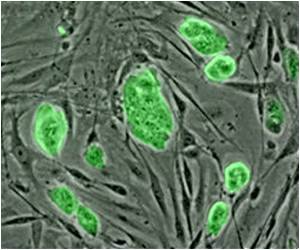CALEC (Cultivated autologous limbal epithelial cells) procedure for stem cell transplant in eye procedures is safe and feasible, showing improved corneal surfaces or vision.

Cultivated autologous limbal epithelial cell (CALEC) transplantation: Development of manufacturing process and clinical evaluation of feasibility and safety
Go to source). In CALEC, stem cells from a patient’s healthy eye are removed via a small biopsy and then expanded and grown on a graft via an innovative manufacturing process at the Connell and O'Reilly Families Cell Manipulation Core Facility at Dana-Farber Cancer Institute. After two to three weeks, the CALEC graft is sent back to Mass Eye and Ear and transplanted into the eye with corneal damage.
Mending your Own Stem Cells for Cornea Damage
CALEC was found to be safe and well-tolerated over the short term in four patients with significant chemical burns in one eye. According to the study published August 18 in Science Advances, the patients who were followed for 12 months experienced restored cornea surfaces — two were able to undergo a corneal transplant and two reported significant improvements in vision without additional treatment.‘The CALEC (Cultivated autologous limbal epithelial cells) procedure intends to address current therapeutic methods for restoring vision with the patient’s own stem cells. #stemcelltherapy #cornealinjuries’





“Cornea specialists have been hindered by a lack of treatment options with a high safety profile to help our patients with chemical burns and injuries that render them unable to get an artificial cornea transplant. We are hopeful with further study, CALEC can one day fill this crucially needed treatment gap",said the principal author Ula Jurkunas, MD.People who experience chemical burns and other eye injuries may develop limbal stem cell deficiency, an irreversible loss of cells on the tissue surrounding the cornea. These patients experience permanent vision loss, pain and discomfort in the affected eye. Without limbal cells and a healthy eye surface, patients are unable to undergo artificial cornea transplants, the current standard of vision rehabilitation.
Existing treatment strategies have limitations and associated risks the CALEC procedure aims to address through its unique approach of using a small amount of a patient’s own stem cells that can then be grown and expanded to create a sheet of cells that serves as a surface for normal tissue to grow back.
Early Potential of Auto-Stem Cells as Clinical Trial Progresses
In the phase I study, five patients with chemical burns to one eye were enrolled and biopsied. Four received CALEC; a series of quality control tests determined the cells in the fifth patient were unable to adequately expand. The CALEC patients were tracked for 12 months.The first patient treated, a 46-year-old male, experienced a resolution of his eye surface defect, which primed him to undergo an artificial cornea transplant for vision rehabilitation. The second, a 31-year-old male, experienced a complete resolution of symptoms with vision improving from 20/40 to 20/30. The third, a 36-year-old male, had his corneal defect resolved and his vision improved from hand motion – only being able to see broad movements like waving – to 20/30 vision. The fourth, a 52-year-old male, initially did not have a successful biopsy that resulted in a viable stem cell graft. After re-attempting CALEC three years later, he underwent a successful transplant and his vision improved from hand motion to being able to count fingers. He then received an artificial cornea.
The researchers are finalizing the next phase of the clinical trial in 15 CALEC patients they are tracking for 18 months to better determine the procedure’s overall efficacy. Their hope is that CALEC can one day become a treatment option for patients who previously had to endure long-term deficits when existing treatment options were not an option given the severity of their injuries.
Advertisement
- Cultivated autologous limbal epithelial cell (CALEC) transplantation: Development of manufacturing process and clinical evaluation of feasibility and safety - ( https://www.science.org/doi/10.1126/sciadv.adg6470)
Source-Eurekalert














